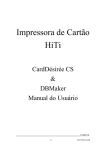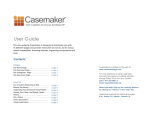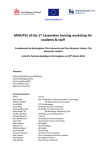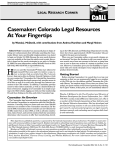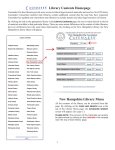Download Trigger User's Guide
Transcript
DBMaker
Trigger User's Guide
P-E9999-Trigger User’s Guide
Version: 01.00
Document No:
43/DBM43-T04212006-01-TRIG
Author: Production Team
Syscom Computer Engineering CO.
Print Date: April 21, 2006
Content
Table of Content
1. Introduction........................................................ 1-1
1.1. Preface of DBMaster Trigger .................................. 1-1
1.2. Additional Resources ............................................. 1-1
1.3. Document Conventions .......................................... 1-2
2. Overview............................................................. 2-1
2.1. Trigger components ............................................... 2-1
2.1.1. TRIGGER NAME ................................................................ 2-2
2.1.2. TRIGGER ACTION TIME ..................................................... 2-2
2.1.3. TRIGGER EVENT............................................................... 2-2
2.1.4. TRIGGER TABLE ............................................................... 2-2
2.1.5. TRIGGER ACTION ............................................................. 2-2
2.1.6. TRIGGER TYPE ................................................................. 2-2
2.1.7. REFERENCING CLAUSE ..................................................... 2-2
2.2. Trigger Operation ................................................... 2-3
3. Creating Triggers ............................................... 3-1
3.1. Creating Trigger syntax.......................................... 3-1
3.1.1. BASIC REQUIREMENTS...................................................... 3-1
3.1.2. SECURITY PRIVILEGES ...................................................... 3-1
3.1.3. CREATE TRIGGER SYNTAX ................................................ 3-1
3.2. Specifying the Trigger Action Time ....................... 3-3
3.2.1. ABOUT THE INSERT TRIGGER EVENT ................................ 3-3
3.2.2. ABOUT THE DELETE TRIGGER EVENT ............................... 3-4
3.2.3. ABOUT THE UPDATE TRIGGER EVENT ............................... 3-5
3.3. Specifying the Trigger Type ................................... 3-6
3.3.1. ABOUT THE FOR EACH ROW ............................................... 3-6
3.3.2. ABOUT THE FOR EACH STATEMENT ..................................... 3-7
3.4. Using the Referencing Clause ................................ 3-8
3.5. Using the WHEN Condition ..................................... 3-8
3.6. Specifying the Trigger Action................................. 3-9
3.7. Using JDBATOOL to Create Trigger ....................... 3-9
3.7.1. ASSIGNING A TRIGGER NAME AND TABLE ......................... 3-9
3.7.2. SPECIFYING TRIGGER ACTION SETTINGS ........................... 3-11
3.7.3. INDICATING THE REFERENCING CLAUSE ............................ 3-12
3.7.4. ENTERING THE WHEN CONDITION CLAUSE ....................... 3-13
3.7.5. ENTERING SQL STATEMENTS FOR THE TRIGGER ACTION .... 3-13
©Copyright 1995-2012 CASEMaker Inc.
i
Trigger User's Guide
4. Modifying A Trigger ............................................ 4-1
4.1. Using dmsql syntax ................................................ 4-1
4.2. Using JDBATOOL .................................................... 4-2
5. Dropping A Trigger ............................................ 5-1
5.1. Using dmsql syntax ................................................ 5-1
5.2. Using JDBATOOL .................................................... 5-1
6. Using Triggers .................................................... 6-1
6.1.
6.2.
6.3.
6.4.
6.5.
Stored Procedures in Action Body ......................... 6-1
Trigger Execution Order ......................................... 6-2
Security and Triggers ............................................. 6-2
Cursors and Triggers .............................................. 6-3
Cascading Triggers................................................. 6-3
7. Enabling and Disabling Triggers ........................ 7-1
8. Creating Trigger Privileges ................................ 8-1
Appendix Tables used in the examples ...................... i
ii
©Copyright 1995-2012 CASEMaker Inc.
Introduction 1
1. Introduction
Welcome to the DBMaster Trigger user’s Guide. This guide discusses the details about the
Trigger and guides the user how to use it. Including how to create Trigger, modify Trigger and
drop Trigger and so on. It provides integrated instances to help user understand.
1.1. Preface of DBMaster Trigger
Triggers are a very useful and powerful feature of the DBMaster database server. Triggers
automatically execute predefined commands in response to specific events, regardless of which
user or application program generated them. Triggers allow a database to be customized in
ways that may not be possible with standard SQL commands. The database can consistently
control complex or unconventional database operations without requiring any action on the part
of users or application programs. Use triggers to:
•
Implement business rules
•
Create an audit trail for database activities
•
Derive additional values from existing data
•
Replicate data across multiple tables
•
Perform security authorization procedures
•
Control data integrity
•
Define unconventional integrity constraints
Exercise restraint when using triggers to avoid forming complex interdependencies within the
database that may be difficult to follow and change. Using triggers can also implement the
desired functionality that cannot be implemented by using standard SQL commands or integrity
constraints.
1.2. Additional Resources
DBMaker provides a complete set of DBMS manuals in addition to this one. For more
detailed information on a particular subject, consult one of the books listed below:
•
For an introduction to DBMaker’s capabilities and functions, referring to the
DBMaker Tutorial.
•
For more information on designing, administering, and maintaining a
DBMaker database, referring to the Database Administrator's Guide.
•
For more information on database server management, referring to the
JServer Manager User’s Guide.
©Copyright 1995-2012 CASEMaker Inc.
1-1
Trigger User's Guide
•
For more information on configuring DBMaker, referring to the JConfiguration
Tool Reference.
•
For more information on the native ODBC API, referring to the ODBC
Programmer’s Guide.
•
For more information on the dmSQL interface tool, referring to the dmSQL
User’s Guide.
•
For more information on the SQL language used in dmSQL, referring to the
SQL Command and Function Reference.
•
For more information on the ESQL/C programming, referring to the ESQL/C
User’s Guide.
•
For more information on error and warning messages, referring to the Error
and Message Reference.
•
For more information on the DBMaker COBOL Interface, referring to the DCI
User’s Guide.
•
For more information on the Stored Procedure, referring to the Stored
Procedure User’s Guide.
•
For more information on the Lock, referring to the Lock User’s Guide.
•
For more information on the DBMaker bundle-version, referring to the
DBMaker bundle Instruction.
•
For more details on the performance of the database, referring to the
Performance Tuning Guide.
1.3. Document Conventions
This book uses a standard set of typographical conventions for clarity and ease of use. The
NOTE, Example, and CommandLine conventions also have a second setting used with
indentation.
CONVENTION
1-2
DESCRIPTION
Italics
Italics indicate the massages returned from the system. It
always means error or warning. It is also used to indicate
a short procedure in the normal paragraph text or the
specification name of the DBMaster.
Boldface
Boldface indicates filenames, database names, table
names, column names, user names, and other database
schema objects. It is also used to emphasize menu
commands in procedural steps.
KEYWORDS
All keywords used by the SQL language appear in
uppercase when used in normal paragraph text.
NOTE
Contains important information or it reminds you to pay
attention.
©Copyright 1995-2012 CASEMaker Inc.
Introduction 1
CONVENTION
 Example
DESCRIPTION
Examples are given to clarify descriptions, and commonly
include text, as it will appear on the screen. Other forms
of this convention include Prototype and Syntax.
Table 1-1 Document Conventions
©Copyright 1995-2012 CASEMaker Inc.
1-3
Overview 2
2. Overview
This chapter tells the basic and necessary knowledge before user creating a trigger. It
contains trigger components and the trigger operation.
2.1. Trigger components
DBMaster stores trigger definitions in the system catalog.
Every DBMaster trigger has six main components:
•
Trigger Name—a name that uniquely identifies the trigger
•
Trigger Action Time—the time relative to when a trigger will be fired
•
Trigger Event—a specific situation that occurs in the database in response to some
user action, such as inserting data into a table
•
Trigger Table—the name of the table that the trigger executes on
•
Trigger Action—an SQL statement or stored procedure that is executed when the
trigger event occurs
•
Trigger Type—the type of trigger
Each of these components must be present in all triggers. In addition, there is an optional
component, the REFERENCING clause.
The picture bellow can help user understand these components.
Picture 2-1 Trigger components
©Copyright 1995-2012 CASEMaker Inc.
2-1
Trigger User's Guide
2.1.1. TRIGGER NAME
The trigger name uniquely identifies a trigger. Trigger names have a maximum length of 32
characters and may contain letters, numbers, the underscore character, and the symbols #
and $. The first character cannot contain a number, and the name cannot contain spaces.
ÂExample:
The followings are valid Trigger names:
trigger1; table1-t1; example#; example$;
The followings are invalid Trigger names:
1trigger; table1 t1; examplesfortrigger-mytriggername1;
2.1.2. TRIGGER ACTION TIME
The trigger action time specifies whether it should fire before or after the SQL statement that
activates it. The trigger action time is specified by the BEFORE and AFTER time keywords.
The BEFORE keyword instructs the trigger to fire before the SQL statement. The AFTER
keyword instructs the trigger to fire after the SQL statement. Only one trigger time can be
specified for each trigger.
2.1.3. TRIGGER EVENT
The trigger event is the database operation that causes a trigger to operate, or fire. The
trigger event may be an INSERT, UPDATE, or DELETE statement that operates on the
trigger table. There can be only one trigger event for each trigger statement. However,
multiple trigger events can be used to activate multiple triggers.
2.1.4. TRIGGER TABLE
The trigger event operates on the associated trigger table. The trigger table must be a base
table; it can not be a temporary table, view, or synonym. A trigger may only have one trigger
table.
2.1.5. TRIGGER ACTION
A trigger action is the command that a trigger executes when it fires. The trigger action may
be an INSERT, UPDATE, DELETE, or EXECUTE PROCEDURE statement. A trigger can
only have a single trigger action.
2.1.6. TRIGGER TYPE
The trigger type specifies how many times the trigger will fire for each trigger event. There
are two kinds of trigger type: row triggers and statement triggers. The FOR EACH ROW
option specifies a row trigger, which fires a trigger action once for each row modified by the
trigger event. The FOR EACH STATEMENT option specifies a statement trigger, which fires
a trigger action once for each trigger event.
2.1.7. REFERENCING CLAUSE
The REFERENCING clause defines correlating names for the old and new values in a
column. This is primarily used when the default OLD and NEW names cannot be used
because of a name conflict with a table.
2-2
©Copyright 1995-2012 CASEMaker Inc.
Overview 2
2.2. Trigger Operation
DBMaster checks to see if a trigger should be fired and will execute the defined triggers
whenever a user or an application program causes a trigger event. Firing triggers within a
database ensures that DBMaster handles data consistently across all applications. So this
guarantees that when a specific event occurs, a related action is also performed.
Users can create triggers to implement domain, column, referential, and unconventional
integrity constraints. However, these can also be done by declarative integrity control.
Triggers do not have an owner, but are associated with a table.
Picture 2-2 Trigger event and action
©Copyright 1995-2012 CASEMaker Inc.
2-3
Creating Triggers 3
3. Creating Triggers
The CREATE TRIGGER command creates a new trigger associated with a specific table.
Only a user with privilege on the trigger table can execute the command. The user must also
have the necessary object privileges for all objects referenced in the trigger definition in
order to successfully create a trigger.
DBMaster also provides the JDBATOOL for user to create Triggers.
3.1. Creating Trigger syntax
Before starting to create a Trigger, the user should know some basic requirements and have
the privilege.
3.1.1. BASIC REQUIREMENTS
All of the CREATE TRIGGER statements must contain at least the following:
•
A trigger name
•
The trigger action time (before or after)
•
The trigger event (insert or delete or update)
•
The trigger table
•
The trigger type (row or statement)
•
The trigger action
3.1.2. SECURITY PRIVILEGES
All SQL statements in the trigger action operate with the same privileges as the owner of the
trigger table, not with the privileges of the user executing the trigger event. If the trigger
exists, any user executing the trigger event will result in the trigger firing.
3.1.3. CREATE TRIGGER SYNTAX
The CREATING TRIGGER SYNTAX is as follows:
©Copyright 1995-2012 CASEMaker Inc.
3-1
Trigger User's Guide
Picture 3-1 Create Trigger Syntax
FOR EACH ROW clause syntax:
Picture 3-2 for each row clause
FOR EACH STATEMENT clause syntax:
Picture 3-3 for each statement clause
 Example:
To create a trigger named TRINSERT2, this trigger fired when insert on the table
EMPLOYEE, and when it fires, the new data will inserted into the table NEWEMPLOYEE.
(Information about the tables EMPLOYEE and NEWEMPLOYEE, please refer the Appendix)
CREATE TRIGGER TRINSERT2 AFTER INSERT ON SYSADM.EMPLOYEE
FOR EACH ROW
3-2
©Copyright 1995-2012 CASEMaker Inc.
Creating Triggers 3
(INSERT INTO SYSADM.NEWEMPLOYEE
VALUES (NEW.ID,NEW.NAME,NEW.ADDR));
3.2. Specifying the Trigger Action Time
As it mentioned previously, the trigger action time is specified by the BEFORE and AFTER
time keywords. You can use the trigger time and trigger type in combination to create four
triggers for each table for the same event (INSERT, DELETE, or UPDATE). For each event
the BEFORE/FOR EACH ROW, AFTER/FOR EACH ROW, BEFORE/FOR EACH
STATEMENT, and AFTER/FOR EACH STATEMENT combinations are possible.
A BEFORE/FOR EACH STATEMENT trigger executes once and only once before the
triggering statement is performed. That is before the occurrence of the trigger event.
An AFTER/FOR EACH STATEMENT trigger executes once and only once after the
triggering statement is complete.
NOTE: the BEFORE and AFTER FOR EACH STATEMENT triggers are executed even if the
triggering statement does not process any rows. More details about FOR EACH
STATEMENT type please refer the chapter 3.3 Specifying the Trigger Type.
3.2.1. ABOUT THE INSERT TRIGGER EVENT
The following examples show how to create triggers that fire before or after INSERT trigger
events. We give one example for each trigger action time. The details of the reference tables
please refer the Appendix.
 Example:
1. To create trigger for BEFORE INSERT Trigger event on table EMPLOYEE:
CREATE TRIGGER TRINSERT1 BEFORE INSERT ON SYSADM.EMPLOYEE
FOR EACH ROW
(INSERT INTO SYSADM.SALARY
VALUES (NEW.ID,NEW.NAME));
Once the TRINSERT1 was created successfully, if there were a new data was
inserted into the table EMPLOYEE, the table SALARY will be added the new
employee’s id and name.
2. To create trigger for AFTER INSERT Trigger event on table EMPLOYEE:
CREATE TRIGGER TRINSERT2 AFTER INSERT ON SYSADM.EMPLOYEE
FOR EACH ROW
(INSERT INTO SYSADM.NEWEMPLOYEE
VALUES (NEW.ID,NEW.NAME,NEW.ADDR));
Also, once the TRINSERT2 was created successfully, if there were a new data was
inserted into the table EMPLOYEE, the table NEWEMPLOYEE will be added the
same new data too.
©Copyright 1995-2012 CASEMaker Inc.
3-3
Trigger User's Guide
When create trigger on INSERT event, user must pay attention to the usage of the
correlation name, it is not allowed to use the OLD correlation name in trigger of INSERT
event. Because the old tuples don’t exist when insert. The following example will cause error:
ERROR (6194): [DBMaker] cannot allow old correlation name in statement trigger or row
trigger of insert trigger event.
CREATE TRIGGER TRINSERT1 BEFORE INSERT ON SYSADM.EMPLOYEE
FOR EACH ROW
(INSERT INTO SYSADM.SALARY
VALUES (OLD.ID,OLD.NAME,NEW.ADDR))
3.2.2. ABOUT THE DELETE TRIGGER EVENT
The following examples show how to create triggers that fire before or after DELETE trigger
events. We give one example for each trigger action time respectively. The details of the
reference tables please refer the Appendix.
 Example:
3. To create trigger for BEFORE DELETE trigger event on table EMPLOYEE:
CREATE TRIGGER TRDELETE1 BEFORE DELETE ON SYSADM.EMPLOYEE
FOR EACH ROW
(DELETE FROM SYSADM.SALARY
WHERE ID = OLD.ID);
Once the TRDELETE1 was created successfully, if there were data was deleted
from the table EMPLOYEE, the data will be deleted from table SALARY either.
4. To create trigger for AFTER DELETE trigger event on table EMPLOYEE:
CREATE TRIGGER TRDELETE2 AFTER DELETE ON SYSADM.EMPLOYEE
FOR EACH ROW
(INSERT INTO SYSADM.DIMISSORY
VALUES(OLD.ID,OLD.NAME,OLD.ADDR))
Once the TRDELETE2 was created successfully, if there were data was deleted
from the table EMPLOYEE, then the data will inserted into the table DIMISSORY.
When create trigger on DELETE event, user must pay attention to the usage of the
correlation name, it is not allowed to use the NEW correlation name in trigger of DELETE
event. Because the new tuples don’t exist when delete. The following example will cause
error: ERROR (6195): [DBMaker] cannot allow a new correlation name in statement trigger
or row trigger of delete trigger event.
CREATE TRIGGER TRDELETE1 BEFORE DELETE ON SYSADM.EMPLOYEE
FOR EACH ROW
(INSERT INTO SYSADM.DEL
3-4
©Copyright 1995-2012 CASEMaker Inc.
Creating Triggers 3
VALUES (NEW.ID,NEW.NAME,NEW.ADDR)
3.2.3. ABOUT THE UPDATE TRIGGER EVENT
The situation is different for UPDATE events. Two types of UPDATE triggers can be created:
UPDATE <table> triggers, or UPDATE OF <column> triggers. An UPDATE <table> trigger
fires whenever the table is updated. An UPDATE OF <column> trigger fires when specific
columns are updated. Either one UPDATE <table> trigger or multiple UPDATE OF
<column> triggers can be created on a single table. I.e. it is not allowed to create UPDATE
<table> trigger and UPDATE OF <column> triggers simultaneously on a single table with the
same action time. But if you want to, please use different action time. UPDATE OF
<column> triggers may contain multiple columns, but columns between all UPDATE OF
<column> triggers in a table must be mutually exclusive.
The details of the reference tables please refer the Appendix.
 Example: BEFORE UPDATE
5. To create trigger for BEFORE UPDATE trigger event on table EMPLOYEE:
CREATE TRIGGER TRUPDATE1 BEFORE UPDATE ON SYSADM.EMPLOYEE
FOR EACH ROW
(UPDATE SYSADM.SALARY
SET ID=NEW.ID,NAME=NEW.NAME WHERE ID=OLD.ID)
Once TRUPDATE1 was created successfully, if a row was updated in the
EMPLOYEE, the row that has the same id in the SALARY will be updated too.
6. To create a column trigger event on the addr column of table EMPLOYEE BEFORE
UPDATE the addr:
CREATE TRIGGER TRUPDATE2 BEFORE UPDATE OF addr ON SYSADM.EMPLOYEE
FOR EACH ROW
(INSERT INTO SYSADM.UPD
VALUES(OLD.ID,NEW.ID,OLD.NAME,OLD.ADDR,NEW.ADDR));
Once TRUPDATE2 was created successfully, when and only when update the addr
column in the EMPLOYEE, the values will be inserted into the table UPD.
NOTE: it is not allowed to create the UPDATE <table> trigger and UPDATE OF
<column> triggers simultaneously within a table with the same action time. So user
shouldn’t create the above two examples on one table simultaneously, if did, it will
return an error message: ERROR (6199): [DBMaker] cannot create update-of-column
trigger if update trigger exists or vice versa.
Also, after create the example6; it will be fail if user attempts to create another column
trigger whose column contains the addr, for example:
CREATE TRIGGER TRUPDATE3 BEFORE UPDATE OF addr, id ON SYSADM.EMPLOYEE
FOR EACH ROW
(INSERT INTO SYSADM.UPD
VALUES (OLD.ID,NEW.ID,OLD.NAME,OLD,ADDR,NEW.ADDR));
©Copyright 1995-2012 CASEMaker Inc.
3-5
Trigger User's Guide
The error massage retuned: ERROR (6198): [DBMaker] illegal column found in update of
column list already existed in other trigger.
Of course, user can create other column triggers on the different columns, for example on id:
7. To create a column trigger event on the id of table EMPLOYEE BEFORE UPDATE
the id :
CREATE TRIGGER TRUPDATE4 BEFORE UPDATE OF id ON SYSADM.EMPLOYEE
FOR EACH ROW
(INSERT INTO SYSADM.UPD
VALUES (OLD.ID,NEW.ID,OLD.NAME,OLD.ADDR,NEW.ADDR));
Once TRUPDATE4 was created successfully, when and only when update the id
column in the EMPLOYEE, the values will be inserted into the table UPD.
 Example: ATFER UPDATE
You can modify the action time to AFTER in example6 or example7 so that it can be create
with the example5 on the same table. As followings:
8. Modifying example6: To create a column trigger event on the addr of table
EMPLOYEE AFTER UPDATE the addr:
CREATE TRIGGER TRUPDATE2 AFTER UPDATE OF addr ON SYSADM.EMPLOYEE
FOR EACH ROW
(INSERT INTO SYSADM.UPD
VALUES(OLD.ID,NEW.ID,OLD.NAME,OLD.ADDR,NEW.ADDR));
Once TRUPDATE2 was created successfully, when and only when after updating
the addr column in the EMPLOYEE, the values will be inserted into the table UPD.
9. Modifying example7: To create a column trigger event on the addr, id of table
EMPLOYEE AFTER UPDATE the addr and id.
CREATE TRIGGER TRUPDATE3 AFTER UPDATE OF addr,id ON SYSADM.EMPLOYEE
FOR EACH ROW
(INSERT INTO SYSADM.UPD
VALUES (OLD.ID,NEW.ID,OLD.NAME,OLD.ADDR,NEW.ADDR));
Once TRUPDATE3 was created successfully, when and only when both the addr
and id were updated, the values will be inserted into UPD.
3.3. Specifying the Trigger Type
The user can choose the Trigger type: FOR EACH ROW or FOR EACH STATEMENT. They
will be described in detail in the following parts.
3.3.1. ABOUT THE FOR EACH ROW
The FOR EACH ROW clause syntax is as bellow:
3-6
©Copyright 1995-2012 CASEMaker Inc.
Creating Triggers 3
Picture 3-4 for each row clause
The FOR EACH ROW clause specifies that a trigger will fire once for each row that the
trigger event modifies. If the trigger event does not modify any rows, the trigger will not fire.
The OLD and NEW keywords are used to identify which values from the trigger table are to
be used in the trigger action. The OLD keyword indicates that trigger table values from
before the trigger event are used in the trigger action. The NEW keyword indicates that
trigger table values from after the trigger event are used in the trigger action.
All the examples we give above are use the FOR EACH ROW trigger type. This type is
flexible because it will fire for each row. If there are several rows were triggered it would be
fire several times.
3.3.2. ABOUT THE FOR EACH STATEMENT
FOR EACH STATEMENT clause syntax:
Picture 3-5 for each statement clause
The FOR EACH STATEMENT clause specifies that a trigger will fire once and only once for
each trigger event. Even if the trigger event statement does not process any rows, the trigger
will fire. And it will be cause error if use the OLD or NEW keyword in the trigger action clause.
 Example:
10. To create a trigger in FOR EACH STATEMENT type:
CREATE TRIGGER TRINSERT3 BEFORE INSERT ON SYSADM.EMPLOYEE
FOR EACH STATEMENT
(INSERT INTO SYASAM.SALARY
VALUES (100,’temporary’.10))
Once TRINSERT3 was created successfully, if there were data was inserted into the
EMPLOYEE, the tuple (100,’temporary’,10) will be insert into table SALARY then.
©Copyright 1995-2012 CASEMaker Inc.
3-7
Trigger User's Guide
3.4. Using the Referencing Clause
In row triggers, the <sql_statement> (or action body) should indicate whether the column
values used are from before or after the trigger event. For example, to log the old ID and
new ID when updating the ID of EMPLOYEE, use the keywords OLD and NEW as shown in
example5.
However, in some rare cases the table’s name may be the NEW or OLD, or the table may
contain columns with the names NEW or OLD. If this is the case, use the referencing clause
to define correlation names. The reference clause allows for the creation of two prefixes that
can be used with a column name: one to reference the old value of the column, and one to
reference the new value. These prefixes are called correlation names. Use the keywords
OLD and NEW to indicate the correlation names.
 Example:
11. To create a trigger for update event on table NEW:
CREATE TRIGGER TRUPDATE5 AFTER UPDATE OF ADDR ON SYSADM.NEW
REFERENCING OLD as pre NEW as post
FOR EACH ROW
(INSERT INTO SYSADM.UPD
VALUES(pre.ID,post.ID,pre.NAME,pre.ADDR,post.ADDR);
Once TRUPDATE5 was created successfully, if the addr column of the table NEW
was updated, the values will be inserted into table UPD.
The details of the reference tables please refer the Appendix.
In this example, the triggering table name is NEW, so the correlation names pre and post are
used in the action body. Referencing clauses are only valid for row triggers, and are not
allowed in statement triggers. If a trigger event is INSERT, there is no old value for the newly
inserted record, so the old value is not available. Similarly, if the trigger event is DELETE,
there is no new value for the deleted record, so the new value is not available. For an
UPDATE event trigger, both old and new values are available.
3.5. Using the WHEN Condition
A WHEN condition clause may precede a FOR EACH ROW triggered action to make the
action execution dependent on the result of a Boolean expression. The when clause
consists of a keyword WHEN followed by the conditional statement in parentheses follows
the action time and precedes the triggered action body, and the WHEN clause is not allowed
in the definition of a statement trigger, it is only allowed in row trigger.
 Example:
12. Modifying the example3 to create a trigger using the WHEN condition:
CREATE TRIGGER TRWHEN BEFORE DELETE ON SYSADM.EMPLOYEE
FOR EACH ROW
WHEN (OLD.ID>0)
3-8
©Copyright 1995-2012 CASEMaker Inc.
Creating Triggers 3
(DELETE FROM SYSADM.SALARY WHERE ID= OLD.ID);
The WHEN condition WHEN (OLD.ID>0) constrains that only the data whose id value
is bigger than 0 could fire the trigger.
3.6. Specifying the Trigger Action
The trigger action is the SQL statement that is performed when the trigger event occurs. The
trigger action can be an INSERT, DELETE, UPDATE, or EXECUTE PROCEDURE
statement. No other statements are allowed. Stored procedures cannot contain COMMIT,
ROLLBACK or SAVEPOINT transaction control statements. Triggers can specify only a
single trigger action, which must be enclosed in parentheses.
 Example:
13. To create trigger specifying the Trigger Action is INSERT, take example1 for
example:
CREATE TRIGGER TRINSERT1 BEFORE INSERT ON SYSADM.EMPLOYEE
FOR EACH ROW
(INSERT INTO SYSADM.SALARY
VALUES (NEW.ID,NEW.NAME));
14. To create trigger specifying the Trigger Action is UPDATE, take example5 for
example:
CREATE TRIGGER TRUPDATE1 BEFORE UPDATE ON SYSADM.EMPLOYEE
FOR EACH ROW
(UPDATE SYSADM.SALARY
SET ID=NEW.ID,NAME=NEW.NAME WHERE ID=OLD.ID)
15. To create trigger specifying the Trigger Action is DELETE, take example3 for
example:
CREATE TRIGGER TRDELETE1 BEFORE DELETE ON SYSADM.EMPLOYEE
FOR EACH ROW
(DELETE FROM SYSADM.SALARY
WHERE ID = OLD.ID);
16. About specifying the Trigger Action is Stored Procedures, we will give example in
the chapter 6.1 Stored Procedures in Action Body.
3.7. Using JDBATOOL to Create Trigger
Beside the above method to create trigger, DBMaster also provides the GUI—JDBATOOL to
guide the user to create a trigger.
3.7.1. ASSIGNING A TRIGGER NAME AND TABLE
The following figures show how to assign a trigger name and indicate the table in which the trigger is
created.
©Copyright 1995-2012 CASEMaker Inc.
3-9
Trigger User's Guide
1. Click the Triggers object in the tree. The Triggers page is displayed.
2. Click Create. The Introduction window of the Create Trigger Wizard is displayed.
3. Click Next. The Name the Trigger window is displayed.
4. Select the table name in which the Trigger will be based on from the Table Name menu.
5. Enter the name of the trigger in the Trigger Name field.
6. Click Next. The Choose the Trigger Action Time window will open.
3-10
©Copyright 1995-2012 CASEMaker Inc.
Creating Triggers 3
3.7.2. SPECIFYING TRIGGER ACTION SETTINGS
1. From the Name the Trigger window of the Create Trigger Wizard, click Next. The
Choose the Trigger Action Time window will open.
2. Select one of the following trigger action time options from the Trigger Action Time:
z To set the trigger to fire before the SQL statement, click the Before option button.
z
To set the trigger to fire after the SQL statement, click the After option button.
3. Select one of the following trigger events from the Trigger Event field:
z To choose the INSERT command as the trigger event. Choose the Insert option.
z To choose the UPDATE command as the trigger event .Choose the Update option.
©Copyright 1995-2012 CASEMaker Inc.
3-11
Trigger User's Guide
z To choose the DELETE command as the trigger event .Choose the Delete option.
z To choose the UPDATE COLUMN command as the trigger event. Choose the
Update on Columns option.
4. Select one of the following trigger type options from the Trigger Type field.
z
Selecting the For each row option button sets the trigger statement to execute
on each row modified by the trigger event.
z
Selecting the For each statement option button sets the trigger statement to
execute upon each instance of the trigger event.
5. If the For each statement option button is selected, clicking Next will open the
Trigger Action window. If the For each row option button is selected. Clicking
Advanced Settings button will open the Referencing clause window.
3.7.3. INDICATING THE REFERENCING CLAUSE
Once you have indicated trigger options and if you selected the FOR EACH ROW as the
trigger type, you can then specify the referencing clause of the trigger. The REFERENCING
clause defines correlation names for the old and new values of a column. This is primarily
used when you cannot use the default OLD and NEW names because a column or the table
has the same name.
1.
From the Choose the Trigger Action Time window of the Create Trigger Wizard
click Advanced Settings. The Referencing clause window is displayed.
2.
Enter a substitute name to refer to the old value in the OLD field.
3.
Enter a substitute name to refer to the new value in the NEW field.
4.
Click OK; return the Choose the Trigger Action Time window.
5.
Click Next, the Specify the WHEN condition clause will open.
3-12
©Copyright 1995-2012 CASEMaker Inc.
Creating Triggers 3
3.7.4. ENTERING THE WHEN CONDITION CLAUSE
Once the settings for the trigger action are complete, and you choose the for each row
trigger to create, you may specify a WHEN clause to place constraints on the actions that
will cause the trigger to fire. A WHEN statement must follow proper SQL syntax.
1. From the Choose the Trigger Action Time window of the Create Trigger Wizard
(if For each row has been specified), click Next. The Specify a WHEN condition
clause window is opened.
2. Enter the WHEN condition and click Next. The Entering the statements for the
trigger action window will open.
3.7.5. ENTERING SQL STATEMENTS FOR THE TRIGGER ACTION
Once the trigger event and its constraints have been defined, the trigger action will be set.
The trigger action is the command or set of commands that the trigger will carry out on all
data that meet the constraints when the trigger is fired.
1. From the Specify a WHEN condition clause, click Next. The Trigger Action window
will open.
2. Enter the SQL statements that are to be performed by the trigger.
©Copyright 1995-2012 CASEMaker Inc.
3-13
Trigger User's Guide
3. Click Next. The Final review window will open.
4. Review the final SQL script. Click Finish if no more changes are to be made. A
message saying the trigger is created successfully is displayed.
3-14
©Copyright 1995-2012 CASEMaker Inc.
Modifying A Trigger 4
4. Modifying A Trigger
A trigger cannot be modified, but its definition can be replaced. When you want to modify a
trigger definition, use the ALTER TRIGGER statement or the JDBATOOL. User can modify
the trigger event, trigger action or trigger type.
4.1. Using dmsql syntax
The ALTER TRIGGGER Syntax is as bellow:
Picture 4-1 Alter trigger syntax
FOR EACH ROW clause syntax:
Picture 4-2 FOR EACH ROW clause syntax
FOR EACH STATEMENT clause syntax:
©Copyright 1995-2012 CASEMaker Inc.
4-1
Trigger User's Guide
Picture 4-3 FOR EACH STATEMENT clause syntax
To replace a trigger action, use the statement ALTER TRIGGER trigger_name REPLACE
WITH.
 Example:
17. To change the Trigger Action for the TRDELETE1 created in Example 3:
ALTER TRIGGER TRDELETE1 REPLACE WITH BEFORE DELETE ON SYSADM.EMPLOYEE
FOR EACH ROW
(DELETE FROM SYSADM.SALARY
WHERE NAME=OLD.NAME);
Now we use the NAME instead of the ID as the where condition.
18. To add another condition to the Trigger Action.
ALTER TRIGGER TRDELETE1 REPLACE WITH BEFORE DELETE ON SYSADM.EMPLOYEE
FOR EACH ROW
(DELETE FROM SYSADM.SALARY
WHERE NAME=OLD.NAME AND ID>15);
Now we add another condition ID>15.
4.2. Using JDBATOOL
The same to the creating trigger, you can also use JDBATOOL to replace the trigger. The
following figures guide you how to do it.
1.
4-2
Click the object Triggers in the tree. All the triggers in the database will be
displayed on the Triggers page.
©Copyright 1995-2012 CASEMaker Inc.
Modifying A Trigger 4
2.
Double click the trigger to be modified, or expand the Triggers node in the tree and
select a trigger from the tree. The Properties page will appear.
3.
Click the Modify button.
4.
To disable the trigger, remove the check mark next to Enable.
5.
To make changes to the SQL script, click in the appropriate place in the SQL
Script field and edit the statement.
6.
Click the Confirm button. The modified trigger will be displayed.
©Copyright 1995-2012 CASEMaker Inc.
4-3
Dropping A Trigger 5
5. Dropping A Trigger
If you will not use a trigger any longer, you can drop it.
5.1. Using dmsql syntax
The DROP TRIGGER statement can be used to delete a trigger from the database. To drop
a trigger, specify the name of the trigger to delete, and the associated table.
The DROP TRIGGER Syntax is as bellow:
Picture 5-1 DORP TIRGGER Syntax
 Example:
19. To drop a trigger:
DROP TRIGGER TRINSERT1 FROM EMPLOYEE;
Deleting a table will cause triggers referencing the table to be deleted. When a table schema
is altered, DBMaster will try to execute the trigger according to the new table definition when
the next time the trigger is executed. If the specified column in a trigger event or action is
dropped, the trigger execution and statement will fail. The only solution is to drop the trigger
or modify the trigger definition according to the new table schema.
20. The follow trigger is the trigger created in Example 3:
CREATE TRIGGER TRDELETE1 BEFORE DELETE ON SYSADM.EMPLOYEE
FOR EACH ROW
(DELETE FROM SYSADM.SALARY
WHERE ID = OLD.ID);
If the column ID in table SALARY is dropped or the type is modified, an execution
error will occur when the triggering statement (delete on EMPLOYEE) is performed
causing the DBMS to attempt to fire trigger TRDELETE1.
5.2. Using JDBATOOL
JDBATOOL allows user to drop the trigger too. The following figures guide you how to do it.
1. Click the object Triggers in the tree. All the triggers in the database will be
displayed.
©Copyright 1995-2012 CASEMaker Inc.
5-1
Trigger User's Guide
2. Select the trigger that is to be dropped by clicking on it.
3. Click Drop. A confirmation window will open to confirm if the trigger is to be dropped.
4. Click OK.
5-2
©Copyright 1995-2012 CASEMaker Inc.
Using Triggers 6
6. Using Triggers
When using triggers, there are more features for trigger you should know, such as how to
use a stored procedure in the action body, what the order of the multiple trigger execute and
so on. And they will be discussed in this chapter.
6.1. Stored Procedures in Action Body
One of the most powerful features of trigger is the ability to use a stored procedure as a
trigger action. The Execute Procedure statement calls a stored procedure, enabling you to
pass data from the triggering table to the stored procedure and then execute the procedure.
 Example:
21. To create a trigger and use the EXECUTE PROCEDURE statement: we have
created a trigger named TRINSERT2 previously in example2 to insert data to table
NEWEMPLOYEE, and now we implement the same function by executing Stored
Procedure.
First, we create a Stored Procedure (more information about stored procedure,
please referring the Stored Procedure User’s Guide of DBMaster):
EXEC SQL CREATE PROCEDURE SYSADM.PROC1(INT ID,CHAR(20) NAME, CHAR(20) ADDR);
{
EXEC SQL BEGIN CODE SECTION;
EXEC SQL INSERT INTO NEWEMPLOYEE VALUES (:ID,:NAME,:ADDR);
EXEC SQL END CODE SECTION;
}
Then, create a trigger and use EXECUTE PRODEDURE statement:
CREATE TRIGGER TRSP1 AFTER INSERT ON SYSADM.EMPLOYEE
FOR EACH ROW
(EXECUTE PROCEDURE
PROC1(NEW.ID,NEW.NAME,NEW.ADDR));
NOTE: before you create this trigger, please drop the trigger TRINSET2 first.
Otherwise, DBMaster will return the error information: ERROR (6573): [DBMaker]
trigger of this type already exists
©Copyright 1995-2012 CASEMaker Inc.
6-1
Trigger User's Guide
Users can pass values to a stored procedure in the argument list. If the stored procedure call
is part of the action for a row trigger, users can use the old and new correlation values to
pass the column values it. If the stored procedure is part of an action statement trigger,
users can only pass constants to the stored procedure. Within a trigger action, you can
update non-triggering columns in the triggering table, with or without a stored procedure. A
stored procedure fired by a trigger cannot contain transaction control statements, like BEGIN
WORK, COMMIT WORK, ROLLBACK WORK, SAVEPOINT, or DDL statements. The stored
procedure as a trigger action cannot be a cursory procedure that returns more than one row.
Please see the Stored Procedure User’s Guide for details about stored procedure.
NOTE: the Stored Procedure which be executed in the trigger should not with returned value,
some keywords such as RETURNS STATUS are not allowed to appear.
6.2. Trigger Execution Order
If there are multiple triggers on one table, the column numbers in the triggering columns
determine the order of trigger execution. The trigger execution begins with the trigger with
the smallest triggering column number and proceeds in order to the highest number.
 Example:
22. To create trigger TRUPDATE6 on table EMPLOYEE:
CREATE TRIGGER TRUPDATE6 BEFORE UPDATE OF addr ON SYSADM.EMPLOYEE
FOR ECHA ROW
(INSERT INTO SYSADM.UPD
VALUES (OLD.ID,OLD,ID,OLD.NAME,OLD.ADDR,OLD.ADDR))
23. To create trigger TRUPDATE7 on table EMPLOYEE:
CREATE TRIGGER TRUPDATE7 BEFORE UPDATE OF id ON SYSADM.EMPLOYEE
FOR EACH ROW
(INSERT INTO SYSADM.UPD
VALUES (NEW.ID,NEW.ID,NEW.NAME,NEW.ADDR,NEW.ADDR))
Now, if operate the SQL statement UPDATE EMPLOYEE SET ID=ID+1, ADDR=’ADDR’ will
fire two triggers – TRUPDATE6 and TRUPDATE7. The TRUPDATE7, which has a lower
triggering column number than TRUPDATE6 will be executed first( id at the front of the addr
in the table EMPLOYEE). So when look the table UPD we will find that the new record is on
the front of the old record.
6.3. Security and Triggers
First, the user must have permission to run the trigger event; otherwise, the user cannot
trigger the event. However, the user does not have to have permission to run the triggered
action because the SQL statements in the triggered action operate under the domain
privilege of the trigger owner. Once a trigger is created successfully, the trigger creator has
privilege to execute the triggered action. Any one else who can issue the triggering
statement can also fire the trigger.
6-2
©Copyright 1995-2012 CASEMaker Inc.
Using Triggers 6
For example, user B can update on both tables T1 and T2, and user A can update T1 only,
but not T2. Now user B creates a trigger on update T1, and the action updates T2. When
user A updates T1, the triggered action (UPDATE T2) is executed successfully since the
triggered action is running under the domain privilege of user B. This security rule simplifies
execution and eliminates the requirement for the user to have more privileges to execute the
triggered action.
6.4. Cursors and Triggers
Update or Delete statements within a cursor act differently than a single update or delete
statement. The entire trigger will be executed with each update or delete with the WHERE
CURRENT OF clause.
For example, if four rows are changed with a cursor, the BEFORE/FOR EACH STATEMENT,
BEFORE/FOR EACH ROW, AFTER/FOR EACH STATEMENT and AFTER/FOR EACH
ROW triggers will be executed four times - once for each row.
6.5. Cascading Triggers
Executing one trigger may cause another trigger to also be executed. You can use
cascading triggers to enforce referential integrity. DBMaster supports a maximum of 64
cascading triggers.
 Example:
Look the following two triggers, when you delete a data from the table EMPLOYEE, the data
will be deleted from the table SALARY as we designed. But when there is data was deleted
from the SALARY, we can delete the same data from the table NEWEMPLOYEE by firing
another trigger.
24. First, the TRDELETE1 was already created previously in example3:
CREATE TRIGGER TRDELETE1 BEFORE DELETE ON SYSADM.EMPLOYEE
FOR EACH ROW
(DELETE FROM SYSADM.SALARY
WHERE ID = OLD.ID);
25. Then, create trigger TRCAS for AFTER DELETE on the table SALARY:
CREATE TRIGGER TRCAS AFTER DELETE ON SYSADM.SALARY
FOR EACH ROW
(DELETE FROM SYSADM.NEWEMPLOYEE
WHERE ID=OLD.ID)
©Copyright 1995-2012 CASEMaker Inc.
6-3
Enabling and Disabling Triggers 7
7. Enabling and Disabling Triggers
When a trigger is created, the trigger is in ENABLED mode, which means the triggered
action executes when the trigger event occurs.
Sometimes users may need to disable a trigger:
z When users have to load a large amount of data, disabling the triggers temporarily
will speed up the loading operation.
z When the objects referenced in a trigger are unavailable.
 Example:
26. To disable the trigger TRUPDATE1 on table EMPLOYEE:
dmSQL>AlTER TRIGGER TRUPDATE1 ON EMPLOYEE DISABLE;
27. To enable the trigger TRUPDATE1 on table EMPLOYEE:
dmSQL>AlTER TRIGGER TRUPDATE1 ON EMPLOYEE ENABLE;
©Copyright 1995-2012 CASEMaker Inc.
7-1
Creating Trigger Privileges 8
8. Creating Trigger Privileges
To create a trigger for a table, a user must be the table owner or DBA. The trigger creator
must have privileges on all objects referenced in the CREATE TRIGGER statement to be
sure successfully create a trigger.
In DBMaster, a trigger has no owner; it is associated with a table. The table owner and DBA
have all privileges associated with a trigger. They can create, drop, or alter the triggers. The
SQL statements in the trigger action operate under the domain privileges of the trigger
owner, instead of the domain privileges of the user executing the trigger event.
©Copyright 1995-2012 CASEMaker Inc.
8-1
Appendix Tables used in the Examples
Appendix Tables used in the
Examples
The following table shows all the tables that used in the previous samples, including the
detail information of tables. It can help user to understand the sample easily.
Table name
Table definition
Table description
EMPLOYEE
create table SYSADM.EMPLOYEE (
Basic table contains the basic
information of the employees;
ID SERIAL(1),
NAME VARCHAR(20) DEFAULT
NULL ,
ADDR VARCHAR(20) DEFAULT
NULL )
IN DEFTABLESPACE LOCK MODE
PAGE FILLFACTOR 80;
SALARY
create table SYSADM.SALARY (
ID SERIAL(1),
Table that stores the salary
information of the employees.
NAME VARCHAR(20) default null ,
SALARY FLOAT default null )
in DEFTABLESPACE LOCK MODE
PAGE FILLFACTOR 80 ;
NEWEMPL
OYEE
create table SYSADM. NEWEMPLOYEE
(
ID SERIAL(1) ,
Used to store the data that was
inserted into the table
EMPLOYEE, that is the latest
employee.
NAME VARCHAR(20) ,
ADDR VARCHAR(20))
IN DEFTABLESPACE LOCK MODE
PAGE FILLFACTOR 80;
DIMISSORY
create table SYSADM. DIMISSORY (
ID SERIAL(1),
NAME VARCHAR(20) default null ,
Used to store the date that was
deleted from the table
EMPLOYEE, that is the dimissory
employee.
ADDR VARCHAR(20) default null )
©Copyright 1995-2012 CASEMaker Inc.
i
Trigger User's Guide
Table name
Table definition
Table description
in DEFTABLESPACE LOCK MODE
PAGE FILLFACTOR 80 ;
UPD
create table SYSADM.UPD (
OLDID INTEGER default null ,
Used to stored the data that was
updated in table EMPLOYEE
NEWID INTEGER default null ,
NAME VARCHAR(20) default null ,
OLDADDR VARCHAR(20) default
null ,
NEWADDR VARCHAR(20) default
null )
in DEFTABLESPACE lock mode page
fillfactor 80 ;
NEW
create table SYSADM.NEW (
Basic table
ID SERIAL(1),
NAME VARCHAR(20) DEFAULT
NULL ,
ADDR VARCHAR(20) DEFAULT
NULL )
IN DEFTABLESPACE LOCK MODE
PAGE FILLFACTOR 80;
Table A-1 Tables used in the Examples
ii
©Copyright 1995-2012 CASEMaker Inc.





































